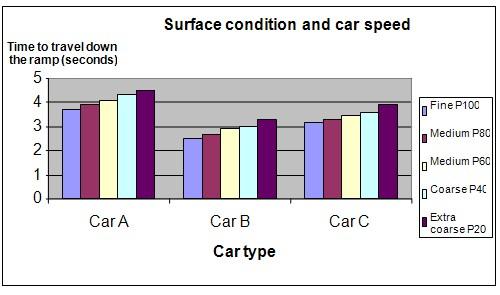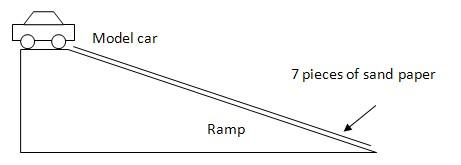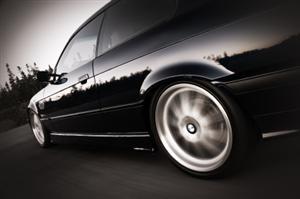| Complexity level: | 6 |
| Project cost ($): | 30 |
| Time required: | 1 hour to prepare, 1 day for the science fair project experiment |
| Material availability: | Easily found |
| Safety concerns: | None |
Hypothesis
Cars move faster on a fine surface and more slowly on a coarse surface.
Overview
Friction and motion
A wheel will start to roll when a linear force is applied to it, provided there is a resistive force present to prevent the wheel from sliding on the surface. This resistive force is called static friction or also known as wheel traction.
The wheel will start to roll forward if the static friction at the contact point is higher than the force from the torque of the wheel. However, if the force of torque is higher than the static friction, the wheel will spin and the static friction will now become kinetic friction. The wheel may still roll forward, but at a slower speed.
Friction is very important to allow a to wheel start its rolling motion, to help the rolling motion stop and to also change the rolling speed of the wheel. As the wheel starts to roll forward, the wheel and the ground will experience surface deformation due to their elastic properties. This will produce rolling friction which will cause the forward velocity of the wheel to reduce. Energy is also lost as heat when the two surfaces are continuously being deformed by compression and relaxed.
Scientific Terms
Materials
The materials required for this science fair project:
- a ramp (at least 2 meter long)
- 3 types of model cars
- 7 pieces of sand paper ISO Grit size P100
- 7 pieces of sand paper ISO Grit size P80
- 7 pieces of sand paper ISO Grit size P60
- 7 pieces of sand paper ISO Grit size P40
- 7 pieces of sand paper ISO Grit size P20
- 1 stopwatch
- 1 ruler
- 1 assistant
- 1 roll of masking tape
Procedure
1. For this science fair project, the independent variable is the surface condition of the ramp (sand paper grit sizes of 100, 80, 60, 40 and 20 are used to create different surface conditions). The dependent variable is the time taken by the model car to travel 2 meters down the ramp. This is determined by measuring the time taken with a stopwatch. The constants (control variables) are the degree of elevation of the ramp, the length of the ramp, the surface condition of the ramp and weight of the cars.
2. The science project experiment is set up as shown in figure 1 above. The start and finish lines are marked using masking tape. The total distance traveled will be 2 meters.
3. 7 pieces of the grit p100 sandpaper are arranged in a straight line on the 2 meter long ramp. The surface of the sand paper will represent the roughness of the floor surface and the amount of friction on the tire of the model car. The sand paper is fixed on the surface of the ramp with masking tape.

4. The first car to be tested is placed on the ramp and with the help of an assistant, the time taken for the car to roll down the 2 meter long ramp is recorded with a stopwatch. The test is repeated 3 times and the average time taken is calculated and recorded in the table below.
5. Procedure 4 is repeated using the other 2 types of model cars and the average time taken is calculated and recorded in the table below.
6. Procedure 3, 4 and 5 are repeated using sandpaper with grit sizes of 80, 60, 40 and 20. The average time taken is calculated and recorded in the table given below.


Results
The results showed that as the surface of the ramp became more coarse, the cars took a longer time to travel 2 meters down the ramp.
|
Model car type |
Sand paper grit and time taken for the model car to travel down the ramp (seconds) |
||||
|
Fine P100 |
Medium P80 |
Medium P60 |
Coarse P40 |
Extra coarse P20 |
|
|
Car A |
3.7 |
3.9 |
4.1 |
4.3 |
4.5 |
|
Car B |
2.5 |
2.7 |
2.9 |
3.0 |
3.3 |
|
Car C |
3.2 |
3.3 |
3.5 |
3.6 |
3.9 |
The graph below represents the results of our science project experiment.

Conclusion
Our hypothesis, that cars move faster on a fine surface and more slowly on a coarse surface.
Also consider
This science fair project may be repeated, this time, by using remote controlled cars.
Modify the science project experiment, increasing the gradient of the ramp in order to increase the speed of the car.
References
Role of friction in starting rolling motion - http://www.school-for-champions.com/science/friction_rolling_start.htm
Rolling friction - http://webphysics.davidson.edu/faculty/dmb/py430/friction/rolling.html

